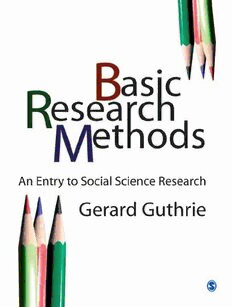
Basic Research Methods: An Entry to Social Science Research PDF
Preview Basic Research Methods: An Entry to Social Science Research
contents i Basic Research Methods ii Basic ReseaRch Methods contents iii Basic Research Methods An Entry to Social Science Research Gerard Guthrie iv Basic ReseaRch Methods Copyright © Gerard Guthrie, 2010 All rights reserved. No part of this book may be reproduced or utilised in any form or by any means, electronic or mechanical, including photocopying, recording or by any information storage or retrieval system, without permission in writing from the publisher. First published in 2010 by Sage Publications India Pvt Ltd B1/I-1 Mohan Cooperative Industrial Area Mathura Road, New Delhi 110 044, India www.sagepub.in Sage Publications Inc 2455 Teller Road Thousand Oaks, California 91320, USA Sage Publications Ltd 1 Oliver’s Yard, 55 City Road London EC1Y 1SP, United Kingdom Sage Publications asia-Pacific Pte Ltd 33 Pekin Street #02-01 Far East Square Singapore 048763 Published by Vivek Mehra for SAgE Publications India Pvt Ltd, typeset in 11/13pt Charter BT by Star Compugraphics Private Limited, Delhi and printed at Chaman Enterprises, New Delhi. Library of Congress Cataloging-in-Publication Data guthrie, gerard. Basic research methods: an entry to social science research/gerard guthrie. p. cm. Includes bibliographical references and index. 1. Social sciences—Research. 2. Social sciences—Research—Methodology. I. Title. H62.g847 300.72—dc22 2010 2010011342 ISBN: 978-81-321-0457-5 (PB) The Sage Team: Elina Majumdar, Sushmita Banerjee, Vijay Sah and Trinankur Banerjee contents v For Karina vi Basic ReseaRch Methods contents vii Contents List of Tables and Figures xiii List of Boxes xv Preface xvii Acknowledgements xix SECTION 1 THE PROBLEM 1 approaches to Research 1.1 The PAPA Model of Research 4 1.2 Stages of Research 6 1.3 Some Actual Research Projects 8 1.4 Research Accuracy 10 1.5 Summary 12 1.6 Annotated References 13 2 Research ethics 2.1 Codes of Ethics 15 2.2 Permissions to Research 16 2.3 Responsibilities 18 2.4 Confidentiality 20 2.5 Feedback 20 2.6 Participatory Research 21 2.7 Summary 22 2.8 Annotated References 23 3 Research Proposal and Literature Review 3.1 Research Proposal 25 3.2 Literature Review 28 3.3 Levels of Analysis 29 3.4 Using the Library and Internet 30 3.5 Abstracting 32 3.6 Word Processing 33 3.7 Plagiarism 35 viii Basic ReseaRch Methods 3.8 Summary 35 3.9 Annotated References 37 4 Research Methodology 4.1 Research Hypotheses 38 4.2 Objective and Subjective 41 4.3 Positivism and Post-positivism 43 4.4 Commonsense and Pragmatism 44 4.5 Mixed Methods 45 4.6 Triangulation 46 4.7 Summary 48 4.8 Annotated References 49 SECTION 2 DATA COLLECTION 5 Sampling 5.1 Justification 53 5.2 Sample Size 54 5.3 Haphazard Sampling 56 5.4 Pure Random Sampling 57 5.5 Systematic Sampling 60 5.6 Non-response 62 5.7 Weighting 63 5.8 Summary 64 5.9 Annotated References 65 6 Case Study Method 6.1 Sampling Principles 66 6.2 Sample of One 67 6.3 Total Population 68 6.4 Theory and Data 70 6.5 Start-up 73 6.6 Researcher’s Role 74 6.7 Summary 74 6.8 Annotated References 76 7 Survey Method 7.1 Sampling Principles 77 7.2 Types of Survey 78 7.3 Implementation Options 80 contents ix 7.4 Survey Protocols 81 7.5 Managing Surveys 83 7.6 Increasing Response Rates 83 7.7 Summary 84 7.8 Annotated References 85 8 experimental Method 8.1 Attributes and Variables 87 8.2 Cause-and-effect 89 8.3 Control 90 8.4 Types of Experimental Design 91 8.5 Quasi-experimental and Ex Post Facto Research 93 8.6 Validity of Experiments 96 8.7 Summary 96 8.8 Annotated References 97 9 available Data 9.1 Sampling Principles 99 9.2 Validity and Reliability 100 9.3 Content Analysis 101 9.4 Presenting Text 102 9.5 Using Numerical Data 104 9.6 Relevance 106 9.7 Summary 106 9.8 Annotated References 107 10 Observation 10.1 Observer Roles 108 10.2 Validity and Reliability 109 10.3 Sampling Techniques 111 10.4 Recording Observations 112 10.5 Testing Theory 113 10.6 Presenting Observational Data 114 10.7 Summary 114 10.8 Annotated References 117 11 Interviews 11.1 Unstructured Interviews 119 11.2 Semi-structured Interviews 120 11.3 Structured Interviews 122 11.4 Narrative 123
